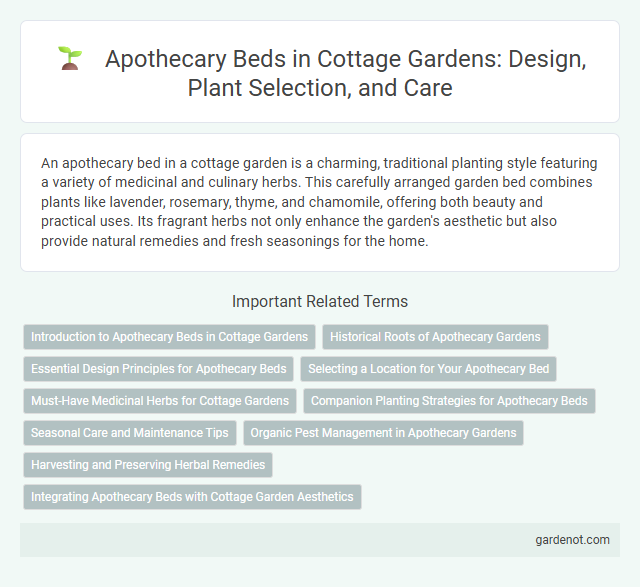An apothecary bed in a cottage garden is a charming, traditional planting style featuring a variety of medicinal and culinary herbs. This carefully arranged garden bed combines plants like lavender, rosemary, thyme, and chamomile, offering both beauty and practical uses. Its fragrant herbs not only enhance the garden's aesthetic but also provide natural remedies and fresh seasonings for the home.
Introduction to Apothecary Beds in Cottage Gardens
Apothecary beds in cottage gardens are traditional planting areas dedicated to medicinal and culinary herbs, reflecting centuries-old practices of herbal healing. These beds typically contain plants like lavender, chamomile, rosemary, and sage, valued both for their fragrance and therapeutic properties. Integrating an apothecary bed enhances the garden's biodiversity while preserving historical gardening heritage.
Historical Roots of Apothecary Gardens
Apothecary gardens trace back to medieval Europe, where monks cultivated medicinal herbs for healing and teaching purposes. These gardens featured plants such as chamomile, lavender, and thyme, reflecting a rich tradition of herbal medicine integral to early cottage gardens. Their design combined functionality with aesthetics, influencing the development of modern cottage garden layouts centered around usable, fragrant plants.
Essential Design Principles for Apothecary Beds
Apothecary beds in cottage gardens emphasize layered planting with a mix of medicinal herbs like lavender, chamomile, and calendula arranged for accessibility and visual appeal. Soil quality must be rich and well-draining to support diverse herb growth and maintain plant health. Incorporating companion planting principles enhances pest control and promotes thriving botanical mixtures that are both functional and ornamental.
Selecting a Location for Your Apothecary Bed
Choose a location for your apothecary bed that receives at least six hours of sunlight daily to support the growth of medicinal herbs like chamomile, lavender, and echinacea. Ensure the soil is well-drained and rich in organic matter to promote healthy roots and potent herbal properties. Position the bed near water access for easy irrigation and consider proximity to your kitchen or herbal workspace for convenient harvesting.
Must-Have Medicinal Herbs for Cottage Gardens
An apothecary bed in a cottage garden is essential for growing must-have medicinal herbs like lavender, chamomile, and calendula, renowned for their healing properties and ease of cultivation. These herbs provide natural remedies for common ailments, making the garden both beautiful and functional. Incorporating echinacea and peppermint enriches the collection, offering immune support and digestive benefits directly from a charming, natural source.
Companion Planting Strategies for Apothecary Beds
Companion planting in apothecary beds enhances the growth and potency of medicinal herbs like chamomile, lavender, and sage by pairing them with beneficial plants such as marigolds and nasturtiums, which repel pests naturally. Strategically combining nutrient-fixing plants like clover with moisture-loving herbs like mint improves soil health and moisture retention. This thoughtful arrangement supports plant resilience and maximizes the therapeutic qualities of the herbs in a cottage garden setting.
Seasonal Care and Maintenance Tips
Apothecary beds require seasonal care to promote healthy growth of medicinal herbs like calendula, chamomile, and lavender. Spring involves soil preparation with organic compost and regular watering to encourage germination, while summer demands consistent pruning and pest control using natural methods. In autumn, mulch application protects roots from frost, and dormant herbs should be pruned back to prepare the bed for winter.
Organic Pest Management in Apothecary Gardens
Apothecary beds in cottage gardens utilize organic pest management techniques to maintain plant health without synthetic chemicals. Companion planting with herbs like basil, rosemary, and lavender naturally repels harmful insects and attracts beneficial predators such as ladybugs and lacewings. Mulching with organic materials and applying neem oil also help control pests, preserving the integrity of medicinal and culinary plants.
Harvesting and Preserving Herbal Remedies
Harvesting herbs from the apothecary bed requires careful timing, usually in the morning when essential oils are most potent, to ensure maximum medicinal properties. Preserving these herbal remedies involves drying leaves, flowers, and roots in a well-ventilated, shaded area to maintain their therapeutic qualities. Proper storage in airtight containers away from light and moisture extends the shelf life and efficacy of homemade herbal preparations.
Integrating Apothecary Beds with Cottage Garden Aesthetics
Apothecary beds blend seamlessly with cottage garden aesthetics by featuring medicinal herbs like lavender, chamomile, and rosemary that contribute both fragrance and traditional charm. The use of rustic wooden or stone borders enhances the natural, informal style, supporting the garden's overall historic and cozy feel. Incorporating a mix of flowering plants alongside functional herbs creates a visually appealing and multifunctional space rooted in herbal tradition.
Apothecary bed Infographic

 gardenot.com
gardenot.com